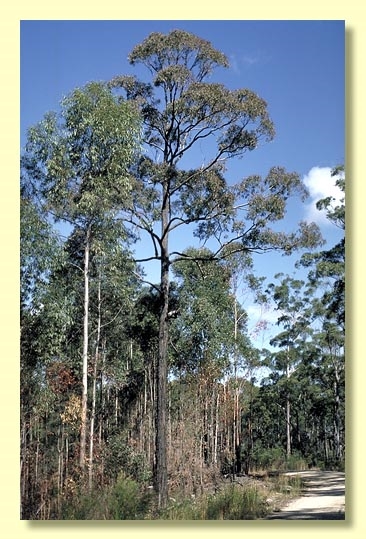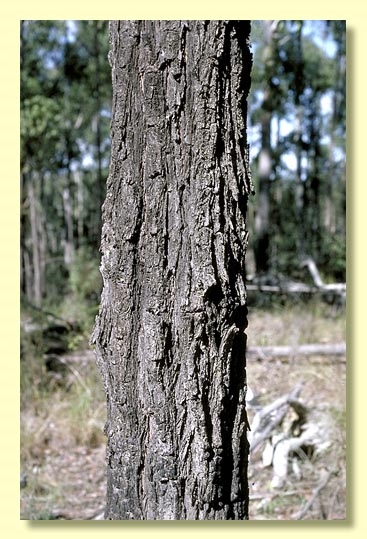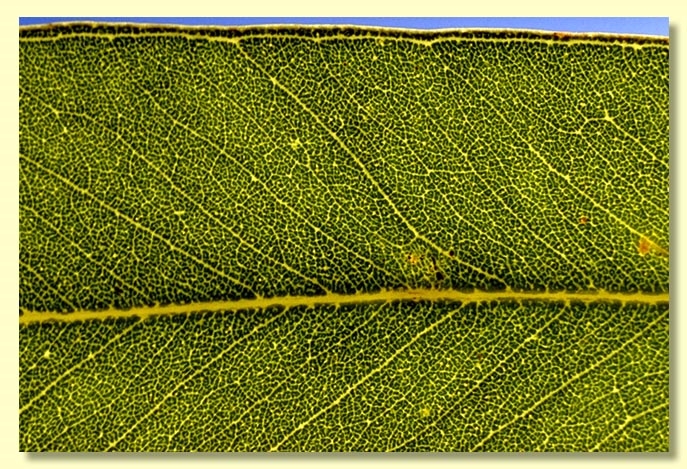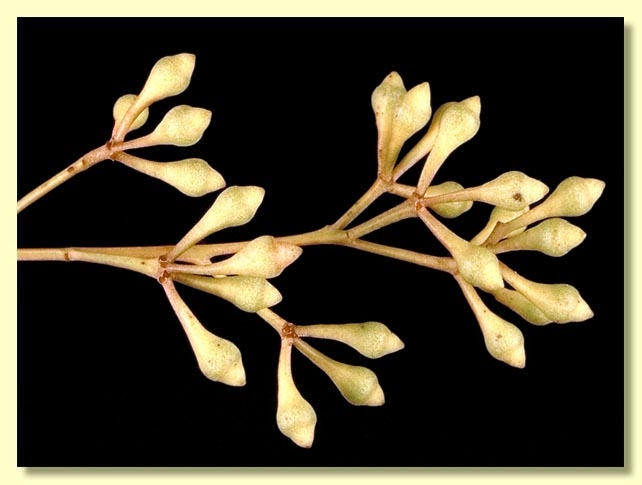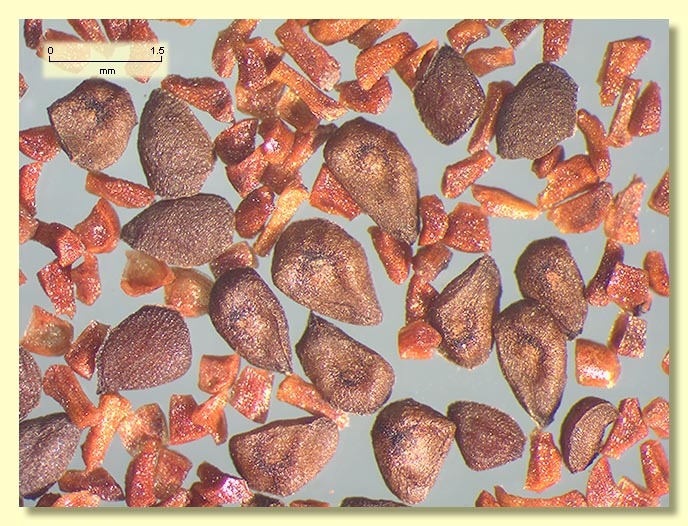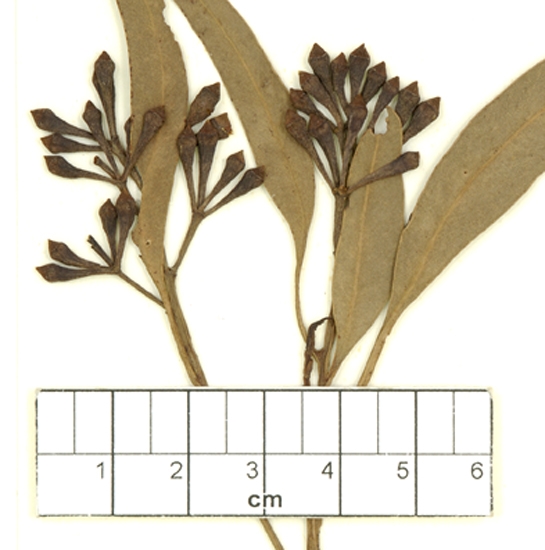Euclid - Online edition
Eucalyptus fusiformis
Eucalyptus | Symphyomyrtus | Adnataria | Terminales | Rhodoxylon | Concolores
Ironbark on trunk and branches ca 5 cm diameter, thick, blackish, soft or hard.
Juvenile growth (coppice or field seedlings to 50 cm): stems square and winged slightly; juvenile leaves always petiolate, opposite to about node 5 or 6, then alternate, ovate to broadly lanceolate, 4–9 cm long, 1.3–4.2 cm wide, bluish green to green, coppice appearing glossy.
Adult leaves alternate, petiole 1.3–2.5 cm long; blade lanceolate to falcate, 7.5–17.5 cm long, 1.3–2.6 cm wide, base tapering to petiole, concolorous, dull, green, side-veins greater than 45° to midrib, dense to very densely reticulate, intramarginal vein parallel to and close to margin or remote from it, oil glands mostly intersectional or obscure.
Inflorescence terminal compound, peduncles 0.3–2 cm long, buds 7 per umbel, pedicels 0.4–0.9 cm long. Mature buds ovoid to fusiform, 0.5–0.9 cm long, 0.3–0.5 cm wide, green to yellow, often with 4 longitudinal ribs, scar present, operculum conical, slightly narrower than hypanthium, stamens inflexed, with outer staminodes, anthers adnate, positioned obliquely at filament tip, cuboid, dehiscing by terminal pores, style long, stigma pin-head shaped, locules 3 or 4, the placentae each with 4 vertical ovule rows. Flowers white.
Fruit pedicellate (pedicels 0.1–0.9 cm long), truncate-ovoid to obconical, relatively long and narrow, 0.5–1 cm long, 0.4–0.5 cm wide, slightly ribbed or angled longitudinally, disc descending, valves 3 or 4, enclosed.
Seeds black or brown, 1.5–2 mm long, flattened-ovoid, often pointed at one end, dorsal surface shallowly pitted, hilum ventral.
Cultivated seedlings (measured at ca node 10): cotyledons reniform; stems square or slightly winged in cross-section; leaves petiolate, opposite for 5 or 6 nodes then becoming alternate, ovate to lanceolate, 4–9 cm long, 1.5–4 cm wide, base tapering, apex to pointed, dull, green.
Flowering has been recorded in May, June, July and August.
A small to medium-sized ironbark tree of relatively dry coastal ranges of New South Wales, particularly on ridges, from north of Kempsey to south of Grafton extending to far south-eastern Queensland (e.g. Mt Barney). Characterised by concolorous dull adult leaves, terminal inflorescences, buds with staminodes and relatively long narrow barrel-shaped to obconical fruit with four or five valves.
Within its subgroup, i.e. subseries Concolores, E. fusiformis is closest to E. dura, E. ancophila, E. melanoleuca, E. corynodes and E. tetrapleura. All have ovate to broadly lanceolate to lanceolate juvenile leaves. E. dura differs only marginally by having glossy to semi-glossy adult leaves and ± obconical fruit (E. fusiformis with dull adult leaves and ± barrel-shaped fruit). E. ancophila differs by having glossy slightly discolorous adult leaves. E. melanoleuca differs by having glossy adult leaves and shorter ovate juveniles. E. corynodes differs by having glaucous to blue-grey adult leaves. E. tetrapleura has larger distinctly four-sided buds and fruit.
Eucalyptus suffulgens, E. panda, E. beyeri, E. virens and E. sicilifolia, also members of the subseries Concolores, differ by having much narrower lanceolate to linear juvenile leaves (ovate to lanceolate in E. fusiformis). The two subspecies in E. caleyi both have dull glaucous adult leaves. E. caleyi subsp. ovendenii differs further by having distinctly four-sided buds and fruit.
All the species in the subseries Discolores, i.e. E. paniculata, E. decolor, E. placita and E. sp. Dorsiventralis, differ by having distinctly discolorous adult leaves (E. fusiformis with concolorous adult leaves). E. sp. Dorsiventralis differs further by having four-sided fruit.
Within its area of occurrence there are other ironbarks which may be confused with E. fusiformis. They are E. crebra, E. fibrosa subsp. fibrosa, E. ophitica and E. siderophloia, all of which differ in having buds with stamens all fertile and irregularly flexed. E. crebra usually occurs further inland than E. fusiformis and has narrower adult leaves. E. fibrosa subsp. fibrosa has buds with a longer conical operculum than that of E. fusiformis. E. ophitica has buds with a rounded blunt operculum (conical in E. fusiformis).
Eucalyptus sideroxylon, of more inland distribution than E. fusiformis, differs by having buds that hold the outer operculum into maturity and both the inner and outer operculum shed together at anthesis (no operculum scar).
MORE ABOUT IRONBARKS

